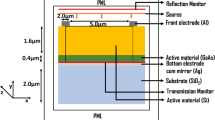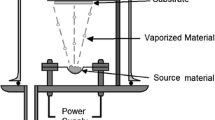Abstract
The application of group IV materials in optoelectronic, electronic and photonic devices is one of the active research fields for Si Photonics. In this paper, we present the design and implementation of direct bandgap Si1 − x−yGeySnx-Si1 − xGex alloy based solar cell emphasizing on thickness reduction and conversion efficiency improvement with Ge composition of 15% and obtained the performance parameters of the structure, including short circuit current density, open circuit voltage, efficiency, fill factors etc. by using ATLAS TCAD simulator. The estimated values and its performance of the proposed structure is compared with the theoretical values of already reported Si1 − xGex based solar cells in the literature. Hence, comparatively better results are obtained. The high efficiency, smaller value of substrate thickness and 15% Ge composition makes the proposed structure attractive for various applications in solar cell industry.
Similar content being viewed by others
Data Availability
Not applicable.
References
Soref R, Kouvetakis J, Tolle J, Menendez J, D’Costa V (2007) Advances in SiGeSn technology. J Mater Res 22(12):3281–3291
Chakraborty V, Dey S, Basu R, Mukhopadhyay B, Basu PK (2017) Current gain and external quantum efficiency modeling of GeSn based direct bandgap multiple quantum well heterojunction phototransistor. Opt Quantum Electron 49(3):1–13
Chang SW, Chuang SL (2007) Theory of optical gain of Ge-SixGeySn1-x-yquantum-well lasers. IEEE J Quantum Electron 43(3):249–256
Kaur J, Basu R, Sharma AK (2019) Effect of separate confinement hetero-structure layer on tunnel injection transistor laser-based transmitter for high-speed optical communication networks. Optics Laser Technol 115(September 2018):268–276
Moontragoon P, Soref RA, Ikonic Z (2012) The direct and indirect bandgaps of unstrained SixGe1-x-ySnyand their photonic device applications. J Appl Phys 112(7). https://doi.org/10.1109/CDE.2017.7905233
Cano P, Lombardero I, Rey-Stolle I, Johnson A, Hoffman R (2017) Multijunction solar cells incorporating group IV SiGeSn alloys. Spanish Conference on Electron Devices, CDE 2017, pp 7–9
Roucka R, Clark A, Landini B (2015) Si-Ge-Sn alloys with 1.0eV gap for CPV multijunction solar cells. AIP Conference Proceedings, vol 1679, no. 2015, pp 0–7
Hussain S, Mehmood H, Khizar M, Turan R (2018) Design and analysis of an ultra-thin crystalline silicon heterostructure solar cell featuring SiGe absorber layer. IET Circuits Devices Syst 12(4):309–314
Chang ST, Liao MH, Lin W (2011) Si / SiGe hetero-junction solar cell with optimization design and theoretical analysis. Thin Solid Films 519(15):5022–5025
Chang G-E, Chang S-W, Chuang SL (2009) Theory for n-type doped, tensile-strained Ge–Si_xGe_ySn_1 – x–y quantum-well lasers at telecom wavelength. Opt Express 17(14):11246
Chang G-E, Chang S-W, Chuang SL (2010) Strain-balanced GezSn1 – z–SixGeySn1 – x–y multiple-quantum-well lasers. IEEE J Quantum Electron 46(12):1813–1820
Teng P, An X, Johnson C, Wenham S, Trupke T, Barnett A (2015) Modeling of increased open circuit voltage through localized emitter area on silicon solar cells. Energy Procedia 77:651–657
Nayak PP, Dutta JP, Mishra GP (2015) Efficient InGaP/GaAs DJ solar cell with double back surface field layer. Eng Sci Technol Int J 18(3):325–335
Michael S, Bates aD, Green MS (2005) Silvaco ATLAS as a solar cell modeling tool. Conference Record of the Thirty-first IEEE Photovoltaic Specialists Conference, pp 719–721
Silvaco (2015) ATLAS Device Simulation Software User’s Manual, no. version 3.2, pp 1–124
Cells SHTS et al (1999) Design, fabrication, and analysis of crystalline Si-SiGe heterostructure thin-film solar cells. IEEE Trans Electron Devices 46(10):2103–2110
Acknowledgements
The authors would like to express their gratitude to the Electronics and Communication Department at NIT Delhi for providing research facilities and assistance in carrying out this work.
Author information
Authors and Affiliations
Contributions
Not applicable.
Corresponding author
Ethics declarations
Ethics Approval
Not applicable.
Consent to Participate
Not applicable.
Consent for Publication
Not applicable.
Competing Interests
Not applicable.
Conflicts of Interest
No conflict of Interest.
Research Involving Human Participants and/or Animals
Not applicable.
Informed Consent
Not applicable.
Additional information
Publisher’s Note
Springer Nature remains neutral with regard to jurisdictional claims in published maps and institutional affiliations.
Rights and permissions
About this article
Cite this article
Kaur, J., Basu, R. & Sharma, A.K. Design and Analysis of Si1-x-yGeySnx-Si1-xGex Alloy Based Solar Cell Emphasizing on Ge Composition 15%. Silicon 15, 397–404 (2023). https://doi.org/10.1007/s12633-022-02025-7
Received:
Accepted:
Published:
Issue Date:
DOI: https://doi.org/10.1007/s12633-022-02025-7




